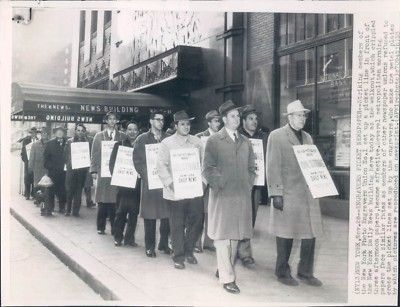
On this day in labor history, the year was 1953. That was the day 400 photo-engravers at six New York City newspapers walked off the job. Members of the AFL’s International Photo-Engravers Union had just voted down arbitration. All but one local newspaper, The New York Herald Tribune were idled as 20,000 newspaper workers refused to cross the engravers picket lines. Six days into the strike, that newspaper suspended operations as well. Writers at The New Yorker magazine remarked they were “curled up with the Wall Street Journal, The Daily Worker and a two-day old copy of La Prense.” In the decades before digital images, photoengraving was a labor-intensive process. Highly skilled workers made metal plates from which newspaper images were printed. Photo-Engravers had been working without a contract since the end of October. They demanded a $15 a week raise. The Newspapers Association was only willing to grant $3.75. The other newspaper unions had been offered similar wage and benefit packages, far below their demands. They knew that whatever they won or lost depended on the victory of the Photo-Engravers strike. So they walked out in solidarity. Federal mediators intervened in an attempt to settle the strike. Hysteric newspaper editors across the country shrieked that the union had accomplished what the government would never dare to do: subvert the freedom of the press! They sulked that the strike had broken 35 years of industrial harmony and peace; adding that the ungrateful workers didn’t appreciate just how good they had it. After eleven days, members voted to end the walkout and let a fact-finding board solve the dispute. Three months later, that board upheld the Newspaper’s Association original offer of $3.75 a week plus benefits.
More Episodes
 2024-05-19
2024-05-19
 2024-05-12
2024-05-12
 2024-05-12
2024-05-12
 2024-05-12
2024-05-12
 2024-05-12
2024-05-12
 2024-05-12
2024-05-12
 2024-05-12
2024-05-12
 2024-05-12
2024-05-12
 2024-05-05
2024-05-05
 2024-05-05
2024-05-05
 2024-05-05
2024-05-05
 2024-05-05
2024-05-05
 2024-05-05
2024-05-05
 2024-05-05
2024-05-05
 2024-04-28
2024-04-28
 2024-04-28
2024-04-28
Create your
podcast in
minutes
- Full-featured podcast site
- Unlimited storage and bandwidth
- Comprehensive podcast stats
- Distribute to Apple Podcasts, Spotify, and more
- Make money with your podcast
It is Free
- Privacy Policy
- Cookie Policy
- Terms of Use
- Consent Preferences
- Copyright © 2015-2024 Podbean.com




